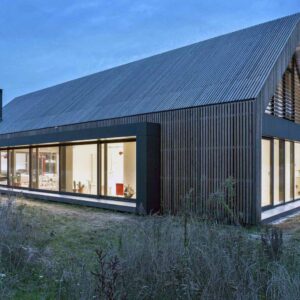The design of a modern living space often seeks to merge the warmth of nature with the cool solidity of contemporary architecture. In this home, the combination of timber and concrete creates a seamless flow, where elements of nature and structure coexist. The use of materials such as these transforms an otherwise ordinary space into a work of art that feels organic, yet refined.



| Architects | http://www.mingarchitects.com/ |
| Images | http://www.studioperiphery.com |
The Beauty of Timber Panels Inside and Out
Timber is an ancient building material, yet it continues to be one of the most beloved choices in modern design. In this home, the use of timber panels is far from traditional. They’re incorporated in a way that allows the warmth of the wood to come alive, both inside and outside the living area. Each timber panel is carefully selected for its texture and grain, giving the walls a tactile feel, as though the space is breathing.
The timber panels extend beyond the interior walls, framing parts of the exterior and continuing into the garden. This continuity between inside and out creates a sense of connection with nature. The wooden tones balance perfectly with the greens of the landscape and the light that filters through the tall windows. Indoors, the timber-clad walls reflect a golden hue, changing with the sunlight that moves through the room during the day.
What sets these timber panels apart is their craftsmanship. Not only are they beautiful to look at, but they are meticulously placed to create a rhythm throughout the living space. Their warmth softens the more industrial elements of the home, such as the concrete and steel, making the living area feel intimate and inviting.



Concrete Walls as a Foundation of Stability
In contrast to the organic feel of timber, concrete provides a sense of strength and permanence. The combination of concrete walls with wooden accents offers an elegant balance of hard and soft. The concrete walls in this living space are not merely functional but also serve as a design statement. With their sleek surfaces and solid appearance, they anchor the room, grounding it in place.
The beauty of concrete lies in its rawness. Here, it has been left in its natural state, allowing its texture to be a focal point. Each concrete surface has been treated to reveal subtle imperfections, which give it character. The material’s simplicity highlights the rich, warm tones of the timber panels that surround it, creating a powerful contrast that is both striking and harmonious.
Concrete walls, though typically considered cold, feel welcoming in this setting. This is partly due to how they interact with the surrounding materials and natural light. The sunlight hitting the smooth concrete surfaces throughout the day creates a soft play of shadows, constantly changing the appearance of the room. The result is a space that feels stable, yet dynamic.



Light and Space Shaped by Timber and Concrete
The play between timber and concrete does not only impact the look and feel of the materials themselves but also shapes the experience of space. The spacious living area is designed to be open, with no unnecessary partitions that might block the flow of light or movement. The timber panels, running vertically along parts of the walls and ceilings, guide the eye upwards and outwards, giving the room a sense of expansion.
Concrete, on the other hand, provides the necessary definition, outlining different areas within the open-plan space. The combination of these two materials forms an interplay of light and shadow that shifts with the day, making the room feel alive. The large glass windows bring in a flood of natural light, which bounces off the timber and concrete, illuminating the textures and creating a warm, inviting atmosphere.
By combining warm wood and raw concrete, this space becomes more than just a living area—it becomes a canvas for light and movement. The materials direct the energy of the room, offering both clarity and comfort to those who inhabit it.


Bringing the Outdoors Inside Through Design
One of the most inspiring aspects of this living area is its relationship with the surrounding landscape. Timber and concrete work together to blur the boundaries between indoors and outdoors, making it feel as though nature itself is a part of the home. The timber panels continue outward to the exterior walls, drawing the eye toward the garden, while the concrete creates a strong frame for the view.
Sliding glass doors open to an outdoor living space that mirrors the materials and tones of the interior, allowing for an easy flow between the two. Timber decks extend outward, offering a place to sit and enjoy the surrounding greenery. The concrete walls, meanwhile, form the perfect backdrop for climbing plants and outdoor seating, emphasizing the union of architecture and nature.
This harmony between the materials and the environment is perhaps what makes the space feel so special. The wood panels reflect the colors of the earth, while the concrete anchors the structure, blending seamlessly with the outdoor landscape. Together, they create a sense of calm and balance, where the natural and built worlds meet.

The artful use of timber and concrete in this home transforms the living area into a space that is both grounded and full of life. Warm wood tones offer a sense of comfort, while the strong presence of concrete provides stability. The way these materials are integrated allows light to shape the space, creating a dynamic environment that feels connected to the natural world. The beauty of the design lies in its simplicity, with every detail crafted to enhance the relationship between structure and landscape.












